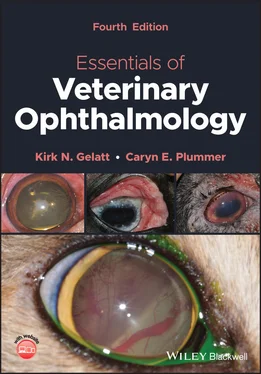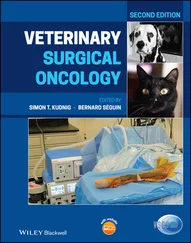The lens epithelium is the major site of energy production in the lens. Energy is used for active transport of inorganic ions and amino acids and for protein synthesis. Osmoregulation occurs through active transport and involves the action of Na +–K +‐ATPase to maintain high K +and amino acid concentrations and low Na +, Cl −, and water concentrations within the lens. The movement of water is passive and occurs with the active cation transport. As the Na +ion is transported from the lens, K +is transported into the lens (see Figure 2.7) in a manner similar to that in red blood cells.
The lens capsule functions as a semipermeable membrane. It prevents direct contact between the lens and the surrounding ocular environment and protects the lens from the invasion of pathogens. However, the capsule allows water, small solutes, many proteins, and waste to pass, thereby enabling the lens to grow and perform metabolic functions. Its mechanical functions include maintaining the shape of the lens in association with accommodating and providing for the attachment of the zonules. Because the lens capsules surround the developing lens before the fetus's immune system develops, leakage of lens cells and material causes lens‐induced uveitis in later life (a major cause for lower cataract surgery success results in the long term).
The primary source of energy for the lens is glucose, which diffuses from the AH. Energy is derived from anaerobic glycolysis and is used for active cation transport and protein synthesis. Oxygen is not necessary for normal lens metabolism, though a small percentage of glucose is metabolized through the Krebs cycle. The hexose monophosphate (i.e., pentose) shunt and the sorbitol pathway are other pathways of glucose metabolism in the lens. The major end product of glucose metabolism in the lens is lactic acid, which diffuses into the AH. The rate of glycolysis is controlled by the amount of hexokinase enzyme and the rate of entrance of glucose into the lens. With high concentrations of glucose (>175 mg/dl), the level of glucose 6‐phosphate increases, which inhibits hexokinase and limits the rate of glycolysis. This process prevents excessive buildup of lactic acid in the lens, which would lower the pH and activate the lens proteases. With very high blood and AH glucose concentrations, as occur in diabetes mellitus, the enzyme aldose reductase is activated as an alternative route of glucose metabolism in the lens. The result is an accumulation of sorbitol in the lens cells, which causes swelling associated with the increased osmotic pressure. The outcome is the intumescent diabetic cataract.
Vitreous
Vitreal Structure and Aging
Physically, the vitreous is a hydrogel that consists of >98% water and fills the large posterior cavity of the eye. Collagen comprises the framework of the vitreous and provides its plasticity. Despite the low protein content, a diverse array of >1200 soluble proteins have been identified in the vitreous. Spaces between the collagen fibers are filled with hyaluronic acid (HA), which provides viscoelasticity to the vitreous .An increase in the collagen content of the vitreous makes it more solid, or gel‐like, while a decrease in the collagen content makes its consistency more fluid. Species differ in the collagen content of their vitreous, which accounts for variability in its consistency. Generally, the cortical areas of the vitreous contain more collagen, so they are more rigid than other portions. The vitreous contains few cells, termed hyalocytes. Hyalocytes belong to the monocyte/macrophage lineage and derive from bone marrow. Their origin is not from glial cells or retinal pigment epithelial cells, as previously thought. Hyalocytes are important for ECM synthesis, vitreous cavity immunology regulation, and modulation of inflammation.
The embryonic vitreous is very dense and therefore translucent. As an individual matures, however, important structural changes occur in the vitreous. The axial length of the vitreous increases, which is critical for growth of the eye (discussed later). The overall collagen content remains unchanged in the adult, but the HA concentration undergoes a fourfold increase in both cattle and humans. This change in the HA‐to‐collagen ratio contributes to greater dispersal of the collagen fibrils, because the newly synthesized HA molecules push the collagen fibril bundles further apart, thus increasing the optical clarity of the vitreous. These changes in HA–collagen interactions as well as in the GAG contents of the vitreous do not cease upon reaching adulthood. Rather, these alterations continue throughout life, and they are believed to be responsible for the vitreal liquefaction observed as part of the aging process in several species. In humans, rheological (i.e., the gel–liquid state of the vitreous) changes begin in the central vitreous at five years of age and continue throughout life, so that in the geriatric patient, more than 50% of the vitreous is eventually liquefied. As liquefaction progresses, the collagen bundles are packed into the remaining gel fraction, whereas HA molecules are redistributed to the liquid fraction. A common complication of this progressive liquefaction is separation of the posterior vitreous cortex from the retinal inner limiting membrane (posterior vitreal detachment). This detachment can predispose to retinal tears, and has been implicated as a risk factor in rhegmatogenous retinal detachment in dogs.
The vitreous is the largest structure in the eye, occupying approximately 80% of the globe. It contributes to the development, optics, structure, physiology, and metabolism of the eye. The vitreous plays an important role in the growth of the eye by contributing to the increase in globe size. Inserting a drainage tube into the vitreous cavity of chicken embryos lowers intravitreal pressure and effectively stops the growth of the eye, and vitrectomy of rabbit eyes has a similar inhibitory effect. In contrast, vitreal elongation will cause an increase in the axial length of the globe. This lengthens the path of the incoming light, thus providing for greater light refraction. In some aquatic species, such as goldfish, this increased vitreal refractivity is a physiological mechanism that compensates for the loss of refractive power when the cornea is submerged in water. In terrestrial species, the increased refraction by the vitreous leads to myopia. Vitreal elongation resulting in axial myopia has been induced through visual deprivation in a number of species, including nonhuman primates, chickens, and cats. This elongation of the vitreous is affected by the synthesis of collagen. Synthesis, molecular reconfiguration, and hydration of HA molecules likewise change the volume of the vitreous and, hence, of the eye.
Diffusion is slow and bulk flow is limited in a gel such as the vitreous. Therefore, topically administered substances are prevented from reaching the retina and optic nerve and systemically administered antimicrobials are unable to reach the center of the vitreous. This slow change of substance concentrations has been used in humans to determine time of death and aid in postmortem diagnosis in manatees.
The optical transparency of the vitreous is primarily due to a low concentration of structural macromolecules (0.2%, w/v) and soluble proteins. Additionally, the configuration of highly hydrated GAG chains separating small‐diameter collagen fibers aids in the passage of light with minimal scattering. Another important factor in optical clarity is the blood–vitreous barrier; HA is thought to act as a barrier that prevents diffusion of macromolecules and cells into the vitreous, except in cases of trauma or cortex disruption. Inflammatory responses, neovascularization, and collagenase activity are likewise suppressed in the vitreous. As a result of these anatomical and physiological properties, the vitreous transmits 90% of light at wavelengths between 300 and 1400 nm.
Читать дальше












